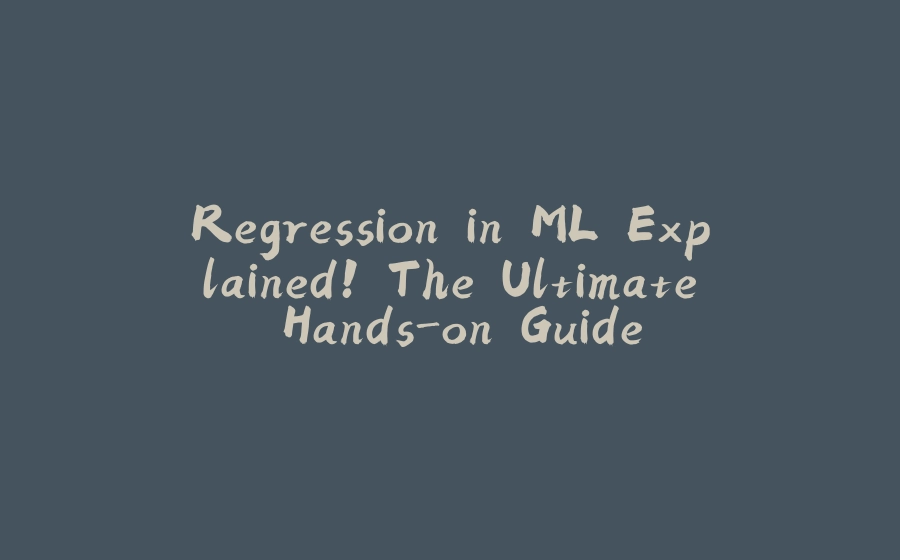How does Netflix know what you’ll binge-watch next? Or how do businesses predict future sales with impressive accuracy?
The magic behind these predictions is Regression—a fundamental technique in Machine Learning!
Whether it’s forecasting house prices , stock trends , or weather patterns ️, regression plays a crucial role in making data-driven decisions. In this guide, we’ll break it all down—step by step—with easy explanations, real-world examples, and hands-on code.
What’s in store for you?
We’ll explore various Regression algorithms, understand how they work, and see them in action with practical applications. Let’s dive in!
1. Linear Regression: The Foundation of Predictive Modeling
Linear Regression is the most fundamental regression technique, assuming a straight-line relationship between input variables (X) and the output (Y). It is widely used for predicting trends, making forecasts, and understanding relationships between variables.
By fitting a linear equation to the observed data, Linear Regression helps in estimating the dependent variable based on independent variables. The equation of a simple linear regression is:
Where:
- Y = Predicted value (dependent variable)
- X = Input feature (independent variable)
- b₀ = Intercept (constant term)
- b₁ = Slope (coefficient of X)
- ε = Error term
Key Applications of Linear Regression:
Stock Market Predictions
Sales Forecasting ️
Real Estate Price Estimation
Medical Research & Risk Analysis ️
️ Implementing Linear Regression in Python:
Let’s implement Simple Linear Regression using Python and Scikit-Learn:
import numpy as np
import matplotlib.pyplot as plt
from sklearn.linear_model import LinearRegression
from sklearn.model_selection import train_test_split
# Sample dataset data_X = np.array([1, 2, 3, 4, 5, 6, 7, 8, 9, 10]).reshape(-1, 1)
data_Y = np.array([3, 4, 2, 5, 6, 7, 8, 9, 10, 12])
# Splitting the data X_train, X_test, Y_train, Y_test = train_test_split(data_X, data_Y, test_size=0.2, random_state=42)
# Model training model = LinearRegression()
model.fit(X_train, Y_train)
# Predictions y_pred = model.predict(X_test)
# Plotting the regression line plt.scatter(data_X, data_Y, color='blue', label='Actual Data')
plt.plot(X_test, y_pred, color='red', linewidth=2, label='Regression Line')
plt.xlabel("Input Feature (X)")
plt.ylabel("Output (Y)")
plt.title("Linear Regression Model")
plt.legend()
plt.show()
Enter fullscreen mode Exit fullscreen mode
Output Visualization:
This simple example demonstrates how Linear Regression can be implemented using Scikit-Learn in Python.
Stay tuned as we explore more regression techniques in the next sections!
Example Use Case:
Predicting house prices based on square footage
Imagine you have a dataset with house sizes and their respective prices. By applying Linear Regression, you can predict the price of a house based on its area!
Tip: Always check model assumptions like linearity, independence, and normal distribution of residuals before applying Linear Regression in real-world scenarios.
Let’s move on to more advanced regression techniques in the next section!
2. Multiple Linear Regression: Expanding Predictive Power
Multiple Linear Regression extends Simple Linear Regression by incorporating multiple input variables to predict an outcome. Instead of modeling a relationship between just one independent variable and the dependent variable, it considers two or more independent variables, making predictions more accurate.
Understanding Multiple Linear Regression
In Multiple Linear Regression, the relationship between the dependent variable (Y) and multiple independent variables (X₁, X₂, X₃, … Xₙ) is represented as:
Equation of Multiple Linear Regression:
Where:
- Y = Dependent variable (what we predict)
- X₁, X₂, X₃, … Xₙ = Independent variables (input features)
- b₀ = Intercept (constant term)
- b₁, b₂, …, bₙ = Coefficients representing the influence of each variable
- ε = Error term
Visual Representation:
1️⃣ Concept of Multiple Regression
2️⃣ Regression Plane Representation (for 2 Variables)
3️⃣ Multiple Linear Regression Formula Breakdown
️ Code Implementation: Mean Squared Error (MSE) in Python
import numpy as np
def mean_squared_error(y_actual, y_pred):
""" Compute the Mean Squared Error (MSE) cost function. Parameters: y_actual : np.array : Actual values y_pred : np.array : Predicted values (mx + c) Returns: float : MSE value """
n = len(y_actual) # Number of data points mse = (1 / n) * np.sum((y_actual - y_pred) ** 2)
return mse
# Example Data x = np.array([1, 2, 3, 4, 5]) # Input features y_actual = np.array([2, 4, 6, 8, 10]) # Actual output values
# Linear regression parameters m = 2 # Slope c = 0 # Intercept
# Compute predictions y_pred = m * x + c
# Compute MSE mse_value = mean_squared_error(y_actual, y_pred)
print("Mean Squared Error (MSE):", mse_value)
Enter fullscreen mode Exit fullscreen mode
Example Use Case: Predicting House Prices
Features considered:
- X₁: Size of the house (sq ft)
- X₂: Number of bedrooms
- X₃: Location rating
- Y: Predicted house price
Advantages of Multiple Linear Regression:
️ Captures the effect of multiple variables for better predictions.
️ Useful for complex real-world scenarios like finance, healthcare, and business analytics.
Challenges of Multiple Linear Regression:
️ More features increase complexity and overfitting risks.
️ Requires careful feature selection and normalization for accuracy.
3. Polynomial Regression: Capturing Non-Linear Trends
When data doesn’t follow a straight-line trend, Polynomial Regression helps model non-linear relationships by introducing polynomial terms to the equation. This technique is useful when the relationship between the independent and dependent variables is curved.
Equation:
Polynomial Regression extends Linear Regression by incorporating higher-degree polynomial terms:
Where:
- Y is the predicted output
- X is the input feature
- b₀, b₁, b₂, …, bₙ are the regression coefficients
- n is the polynomial degree
- ε is the error term
Real-World Applications of Polynomial Regression:
- Salary Prediction: Estimating salary growth over time, where experience influences salary in a non-linear fashion.
- 🦠 COVID-19 Trend Forecasting: Modeling infection rate trends, which often follow polynomial or exponential growth.
- Vehicle Performance Modeling: Predicting fuel consumption based on speed and engine performance.
- Economics & Finance: Forecasting demand, inflation, and economic trends where relationships are complex.
Advantages:
️ Works well for curved datasets where Linear Regression fails.
️ Provides a better fit for non-linear trends when the correct degree is chosen.
Disadvantages:
Can overfit the data if the polynomial degree is too high.
Harder to interpret compared to simple Linear Regression.
️ Python Code for Polynomial Regression:
import numpy as np
import matplotlib.pyplot as plt
from sklearn.preprocessing import PolynomialFeatures
from sklearn.linear_model import LinearRegression
from sklearn.pipeline import make_pipeline
# Sample dataset X = np.array([1, 2, 3, 4, 5, 6, 7, 8, 9, 10]).reshape(-1, 1)
y = np.array([2, 5, 10, 18, 30, 50, 75, 105, 140, 180])
# Creating a polynomial model (degree = 2) poly_model = make_pipeline(PolynomialFeatures(degree=2), LinearRegression())
poly_model.fit(X, y)
y_pred = poly_model.predict(X)
# Plot results plt.scatter(X, y, color='blue', label='Actual Data')
plt.plot(X, y_pred, color='red', linewidth=2, label='Polynomial Regression Line')
plt.xlabel("Input Feature (X)")
plt.ylabel("Output (Y)")
plt.title("Polynomial Regression Model")
plt.legend()
plt.show()
Enter fullscreen mode Exit fullscreen mode
Visual Representation:
Polynomial Regression allows machine learning models to capture non-linear relationships and make better predictions in real-world scenarios.
4. Logistic Regression (For Classification) :
Although it contains “Regression” in its name, Logistic Regression is used for Classification problems, not Regression.
Instead of predicting continuous values, it predicts probabilities and assigns categories like Yes/No, Pass/Fail, Spam/Not Spam.
Equation:
where P is the probability of belonging to a class.
Example:
- Predicting whether a customer will buy a product (Yes/No).
- Classifying emails as spam or not.
Why is it called Regression?
Although it’s used for classification, Logistic Regression applies a regression-based approach before applying the Sigmoid function to convert outputs into probabilities.
️ Python Implementation of Logistic Regression
import numpy as np
import matplotlib.pyplot as plt
from sklearn.model_selection import train_test_split
from sklearn.linear_model import LogisticRegression
from sklearn.metrics import accuracy_score, classification_report
# Sample dataset (Binary classification: Pass (1) or Fail (0)) X = np.array([[20], [25], [30], [35], [40], [45], [50], [55], [60], [65]]) # Hours studied y = np.array([0, 0, 0, 1, 1, 1, 1, 1, 1, 1]) # 0 = Fail, 1 = Pass
# Splitting dataset X_train, X_test, y_train, y_test = train_test_split(X, y, test_size=0.2, random_state=42)
# Training Logistic Regression model model = LogisticRegression()
model.fit(X_train, y_train)
# Predictions y_pred = model.predict(X_test)
# Evaluating model accuracy = accuracy_score(y_test, y_pred)
print("Accuracy:", accuracy)
print("Classification Report:\n", classification_report(y_test, y_pred))
# Plotting the sigmoid curve X_range = np.linspace(15, 70, 100).reshape(-1, 1)
y_probs = model.predict_proba(X_range)[:, 1]
plt.scatter(X, y, color='blue', label='Actual Data')
plt.plot(X_range, y_probs, color='red', label='Sigmoid Curve')
plt.xlabel("Hours Studied")
plt.ylabel("Probability of Passing")
plt.title("Logistic Regression Model")
plt.legend()
plt.show()
Enter fullscreen mode Exit fullscreen mode
Expected Output:
Accuracy: 1.0 # (Might vary slightly depending on random split)
Classification Report:
precision recall f1-score support
0 1.00 1.00 1.00 1
1 1.00 1.00 1.00 1
accuracy 1.00 2
macro avg 1.00 1.00 1.00 2
weighted avg 1.00 1.00 1.00 2
Enter fullscreen mode Exit fullscreen mode
This implementation demonstrates how Logistic Regression is used for binary classification. The model predicts whether a student will pass or fail based on study hours, and we visualize the sigmoid function curve.
Conclusion: Regression in Machine Learning
Regression is a fundamental concept in Machine Learning, enabling us to make continuous predictions based on input features. It is widely used in forecasting, trend analysis, and data-driven decision-making.
Quick Summary of Regression Algorithms
| Algorithm | Use Case | Equation Type | Best For |
|---|---|---|---|
| Linear Regression | Predicting sales, stock prices | Linear equation | Simple relationships between variables |
| Multiple Regression | House pricing with multiple factors | Linear (Multiple Inputs) | Impact of multiple features |
| Polynomial Regression | Salary growth trends, COVID-19 cases | Polynomial equation | Capturing non-linear patterns |
| Logistic Regression | Spam detection, customer conversion | Sigmoid function | Classification problems |
Key Takeaways
Regression is essential for predictive modeling in real-world applications.
Choosing the right regression technique depends on data patterns and relationships.
Logistic Regression is used for classification, despite its name.
Regression models power AI-driven decision-making, forming the backbone of modern analytics and forecasting!
原文链接:Regression in ML Explained! The Ultimate Hands-on Guide
























暂无评论内容